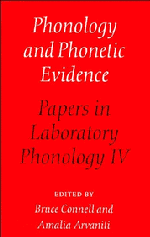Book contents
- Frontmatter
- Contents
- List of contributors
- Acknowledgments
- 1 Introduction
- I Features and Perception
- II Prosody
- 8 Stress shift: do speakers do it or do listeners hear it?
- 9 The phonology and phonetics of the Rhythm Rule
- 10 The importance of phonological transcription in empirical approaches to “stress shift” versus “early accent”: comments on Grabe and Warren, and Vogel, Bunnell, and Hoskins
- 11 Perceptual evidence for the mora in Japanese
- 12 On blending and the mora: comments on Kubozono
- 13 Toward a theory of phonological and phonetic timing: evidence from Bantu
- 14 On phonetic evidence for the phonological mora: comments on Hubbard
- III Articulatory Organization
- Subject index
- Index of names
- Index of languages
10 - The importance of phonological transcription in empirical approaches to “stress shift” versus “early accent”: comments on Grabe and Warren, and Vogel, Bunnell, and Hoskins
Published online by Cambridge University Press: 03 May 2011
- Frontmatter
- Contents
- List of contributors
- Acknowledgments
- 1 Introduction
- I Features and Perception
- II Prosody
- 8 Stress shift: do speakers do it or do listeners hear it?
- 9 The phonology and phonetics of the Rhythm Rule
- 10 The importance of phonological transcription in empirical approaches to “stress shift” versus “early accent”: comments on Grabe and Warren, and Vogel, Bunnell, and Hoskins
- 11 Perceptual evidence for the mora in Japanese
- 12 On blending and the mora: comments on Kubozono
- 13 Toward a theory of phonological and phonetic timing: evidence from Bantu
- 14 On phonetic evidence for the phonological mora: comments on Hubbard
- III Articulatory Organization
- Subject index
- Index of names
- Index of languages
Summary
Introduction
The titles used by Grabe & Warren and Vogel, Bunnell & Hoskins indicate agreement on a central point about the study of “stress shift” (or perceived early prominence in the word): it is critical to investigate this phenomenon from several different points of view at the same time. Although the authors differ in their methods, findings, and conclusions about early prominence, they share the conviction that an adequate test of early prominence theories requires several different kinds of data. These include perceptual judgments and acoustic measurements of the test utterances, which should contain a number of different target words in a number of different contexts, produced by more than a single speaker and judged by more than one listener. It will be argued here that a key addition to this list of requirements is a phonological transcription of the prosodic structure of the utterances as they are actually produced.
This information is critical to the interpretation of all other data, because speakers have a number of options for the prosodic structure of a given sentence, and their choice is not always predictable from the text alone. A prosodic transcription allows us to evaluate two different kinds of predictions: predictions about the contexts in which early prominence will occur, and proposals about the acoustic cues that signal early prominence when it does occur. The requisite phonological transcription includes both the prosodic constituent structure and the distribution of phrase-level prosodic prominences (pitch accents) in each utterance.
- Type
- Chapter
- Information
- Phonology and Phonetic EvidencePapers in Laboratory Phonology IV, pp. 128 - 140Publisher: Cambridge University PressPrint publication year: 1995
- 6
- Cited by



